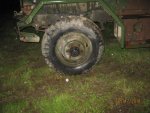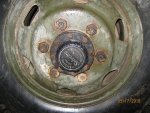It is difficult for me to put this into words as I've tried so many times. This is all about the rear tandems, I'll touch on the front a little later. Now, as far as spider gears, forget everything you already knew about spiders with a single rear axle. The problem with the deuce (and 5 tons) is that there is no inter axle disconnect. As long as that drive shaft between the tandems is there, both differentials are spinning at the same speed. I'm sure we can all agree on that. Lets assume that the rear most axle remains complete with both axles in place. As we go around turns, the spider gears will alow differentiation between both sides. Going straight, the spiders have virtually no movement (unless a radical difference in tire rollout from side to side). Once we add a second axle in front of that, we add a little bind as we go around corners as the axles don't follow the same arc. Another contributing factor is tire size on this one. So far all still elementary. So, in order to relieve that bind we have to figure out a way to unlock something. Herein comes the single lockout. Since the differentials are open, unlocking one side renders that axle useless as all torque will be sent to the side with the least resistance (side with no axle), of course assuming there is no locking diff. In place of removing an axle, the idea of the single lockout was born. Since both differentials are spinning at the same speed and the rear tires are setting the road speed, with one axle removed, that other tire and axle is maintaining the same axle RPM as the aft axle. That means that the axle gears in both differentials are spinning at the same RPM as the carrier, and if they are, the spider gears will not be moving. It's difficult for me to put it into words but I can guarantee you that the spiders in the unlocked axle will not be spinning at random.
As far as the speed bump incident, I did live that one. I had desplined hubs up front so only one driive axle available to push. If I had the front hubs on, coulda just switched to AWD and drove away.
Now lets cover tire matching while we are at it. Mechanically, this is the best way to match your rear tires. Adjust all tires to same pressure. Measure a rolling circumference of each tire and write it on the tire. Take your longest circumference 2 tires, pair them up and set them aside for one axle (either one) Now take your shortest 2 tires, pair them up and put them aside for install on the same axle as the longest. The remaining 4 tires should be done the same, 2 shortest on one side and 2 tallest on the other side. This will equalize rollout of each axle to the best it can be done mechanically.





